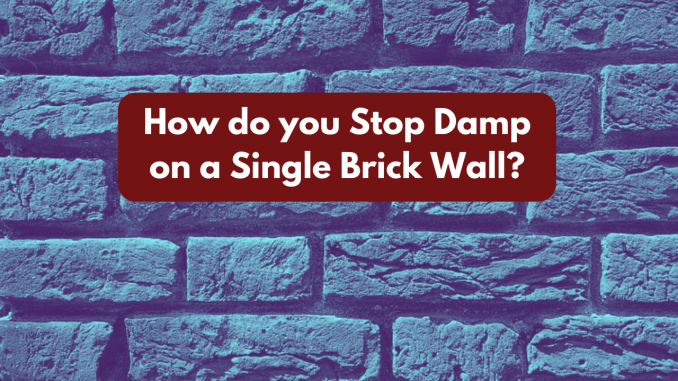
Dampness can wreak havoc on a single brick wall, causing a range of structural and aesthetic issues if left unchecked. From compromising the integrity of the bricks and mortar to fostering the growth of mould and mildew, dampness poses significant risks to the overall condition and longevity of the wall.
Understanding the potential consequences of dampness is essential for homeowners and property managers, as it underscores the importance of implementing effective damp-proofing measures to protect the integrity of single brick walls. In this introduction, we’ll explore the various ways in which damp can adversely affect a single brick wall and discuss strategies for mitigating its impact to preserve the structural integrity and appearance of the wall.
Here is a guide to how you can help prevent damp from taking over your brick wall:
Identifying the Source of Moisture
Before taking any action, it’s crucial to pinpoint the source of moisture affecting the brick wall. This can include leaking pipes, rainwater penetration, rising damp, condensation, or inadequate ventilation.
Repairing Leaks
If the dampness is caused by leaking pipes or a damaged roof, it’s essential to repair these issues promptly. Fixing leaks will prevent water from entering the wall and causing further damage.
Improving Drainage
Ensure that the ground surrounding the wall slopes away from the building to prevent rainwater from pooling and seeping into the bricks. Installing proper drainage systems can help divert water away from the wall, reducing the risk of dampness.
Applying Waterproofing Treatments
Consider applying waterproofing coatings or sealants designed for brick surfaces. These products create a barrier that repels water, preventing it from penetrating the brick wall and causing dampness.
Enhancing Ventilation
Inadequate ventilation can lead to condensation build up, especially in areas with high humidity like bathrooms and kitchens. Installing vents or extractor fans can improve air circulation, reducing moisture levels inside the building and minimising dampness on the wall.
Installing a Damp-Proof Course (DPC)
If rising damp is the issue, installing a damp-proof course may be necessary. A DPC is a waterproof layer installed horizontally in the wall near ground level to block moisture from rising through the bricks.
Repairing Mortar Joints
Cracked or deteriorated mortar joints can allow water to penetrate the wall. Repointing the joints with new mortar can seal gaps and prevent dampness from affecting the brick wall.
Improving Insulation
Improving the insulation of the brick wall can help prevent condensation by maintaining the surface temperature above the dew point. Insulation materials such as foam board or mineral wool can be installed on the interior or exterior of the wall to reduce the risk of dampness.
Consulting Professionals
If the issue persists or if you’re unsure about the appropriate solution, it’s advisable to consult a professional damp specialist or building surveyor. They can assess the situation and provide expert recommendations tailored to your specific needs.
Can you Damp Proof a Single Brick Wall?
Damp-proofing a single brick wall is indeed feasible, but the efficacy of the approach depends significantly on the underlying causes of dampness. The process typically involves identifying the source of moisture and implementing targeted solutions to prevent its penetration into the brickwork.
Various factors such as leaking pipes, rainwater ingress, rising damp, condensation, or inadequate ventilation can contribute to dampness in a brick wall. Addressing these issues may require different strategies, ranging from repairing leaks and improving drainage to applying waterproofing treatments or installing damp-proof courses. Moreover, ensuring proper ventilation and insulation can play crucial roles in mitigating moisture-related problems, especially in areas prone to high humidity or condensation build up.
Implementing damp-proofing measures on a single brick wall requires a systematic approach tailored to the specific circumstances of the structure. While some solutions, such as repairing leaks or improving drainage, may be relatively straightforward, others, like installing damp-proof courses or improving insulation, might necessitate professional expertise.
Additionally, regular maintenance and periodic inspections are essential to ensure the long-term effectiveness of damp-proofing efforts. By addressing dampness proactively and employing appropriate damp-proofing techniques, it’s possible to safeguard single brick walls against moisture-related damage and maintain a dry, healthy indoor environment.


Leave a Reply